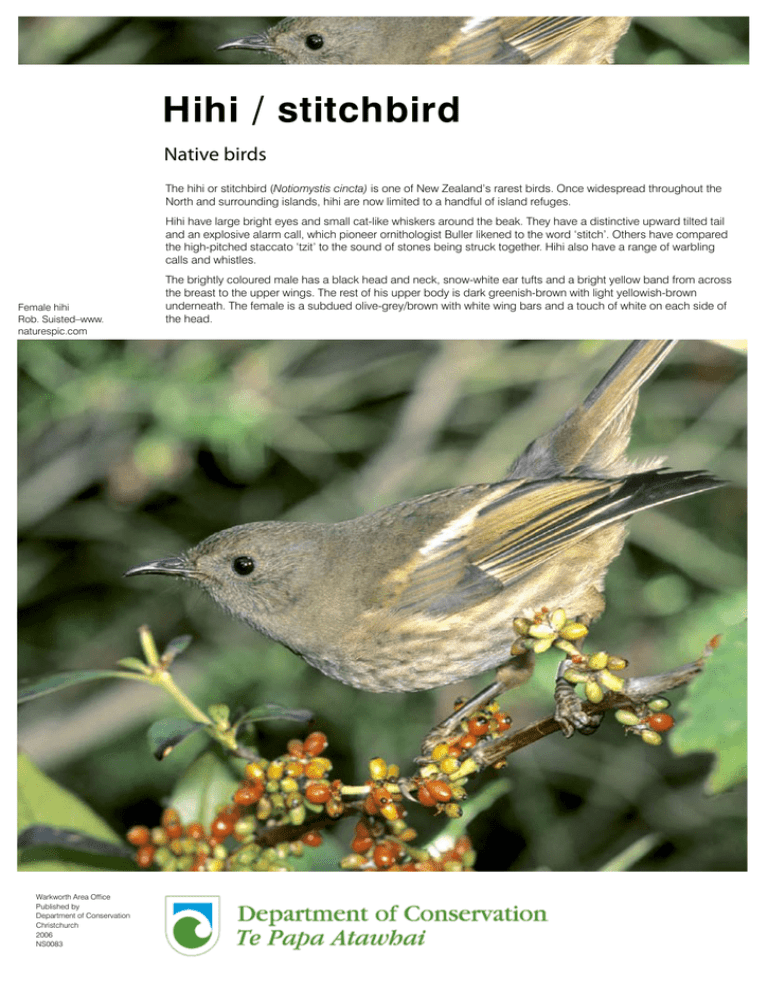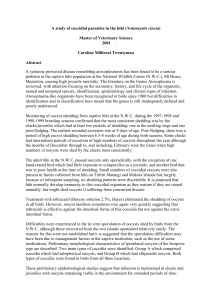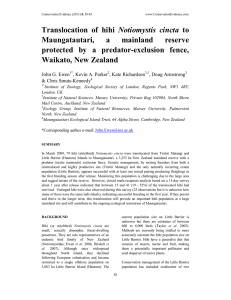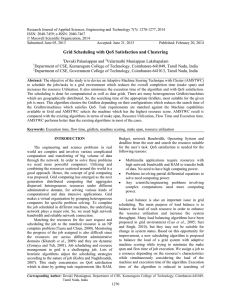Hihi / stitchbird - Department of Conservation
advertisement

Hihi / stitchbird Native birds The hihi or stitchbird (Notiomystis cincta) is one of New Zealand’s rarest birds. Once widespread throughout the North and surrounding islands, hihi are now limited to a handful of island refuges. Hihi have large bright eyes and small cat-like whiskers around the beak. They have a distinctive upward tilted tail and an explosive alarm call, which pioneer ornithologist Buller likened to the word ‘stitch’. Others have compared the high-pitched staccato ‘tzit’ to the sound of stones being struck together. Hihi also have a range of warbling calls and whistles. Female hihi Rob. Suisted–www. naturespic.com Warkworth Area Office Published by Department of Conservation Christchurch 2006 NS0083 The brightly coloured male has a black head and neck, snow-white ear tufts and a bright yellow band from across the breast to the upper wings. The rest of his upper body is dark greenish-brown with light yellowish-brown underneath. The female is a subdued olive-grey/brown with white wing bars and a touch of white on each side of the head. Did you know? • • • • • • Recent DNA analysis shows that hihi are not, as scientists thought, part of the honeyeater family with tüï and bellbird: They are the only member of a bird family whose closest relatives may be the iconic wattlebirds huia (extinct), kökako and tïeke (saddleback). Hihi are the only birds known to copulate face to face. Researchers think this occasional behaviour is made possible by the male’s unusually generous cloaca. Mäori used the bright yellow shoulder feathers of the male to provide colour highlights for cloaks (käkahu). Hihi mating behaviour is variable: If nest sites are close together a single male may pair with several females; if sites are far apart they breed in pairs. Even paired males try constantly to mate with females from other pairs, making it hard to work out parentage. Hihi nest in tree-holes. Hihi play third fiddle to tui and korimako (bellbird) when competing for nectar, insects and berries. Hihi recovery plan The Department of Conservation (DOC) aims to establish five self-sustaining hihi populations. Some steps toward this are to: • Protect the original Huaturu population, especially by keeping it predator-free. • Establish self-sustaining populations at predatorfree sites. • Monitor and where necessary support each population. • • Improve knowledge of hihi through research. DOC has moved a series of hihi colonies from their original population on Hauturu / Little Barrier Island to predator-free Kapiti and Tiritiri Matangi Islands and to the Karori Wildlife Sanctuary in Wellington. Hihi at these sites are supported with nectar feeders and artificial nesting boxes. DOC staff also control mites in the nesting boxes and remove infertile egg clutches to encourage successful re-nesting. Research Fight for survival The last sighting of hihi on the mainland was in 1883 in the Tararua Range. Their decline coincided with the introduction to New Zealand of predators such as cats and ship rats. Huaturu / Little Barrier Island, host to the last natural population, was declared a bird sanctuary in 1894. Male hihi D. Veitch Maintain a small captive population at the Pukaha Mount Bruce National Wildlife Centre in eastern Wairarapa. Recent hihi research led by Massey University has led to the management of mites in nests, to the sexing and cross-fostering of chicks and to an improved understanding of habitat needs. Observation of captive populations at Pukaha Mount Bruce National Wildlife Centre has helped DOC to understand the vulnerability of hihi to diseases and parasites which came to New Zealand with domestic birds. How can you help? The survival of the hihi depends upon their fragile island sanctuaries remaining fire and predator-free. Please: • If you are anchoring near an island sanctuary, keep rodent bait stations on board and check your boat for rodent stowaways. If a pregnant rat swam ashore from your boat onto a predator-free island, it could undo years of pest eradication work. • Please don’t let dogs or cats anywhere near island sanctuaries. • Do not let off flares near island sanctuaries except in emergencies. They can cause fires. Businesses can sponsor hihi recovery through the Threatened Species Trust, a partnership between corporate sponsors, the Department of Conservation, Royal Forest and Bird Protection Society and the New Zealand Conservation Authority. For more information on hihi visit the DOC website at www.doc.govt.nz.




